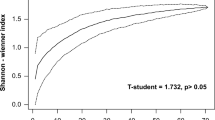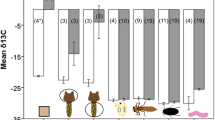Abstract
Velvet worms (Onychophora) are characterised by a dearth of mechanisms to retain water, yet recently identified cryptic species are located in areas with seemingly different climates. Using flow-through respirometry, this study determined the metabolic, water loss and cuticular water loss rates of two cryptic species of Opisthopatus cinctipes s.l. from locations that differ in their current climate. When controlling for trial temperature and body mass, velvet worms from the drier and warmer site had significantly lower water loss rates than the wetter and cooler site. Mass-corrected metabolic rate and cuticular water loss did not differ significantly between the two sites. The scaling exponent for the relationship between log metabolic rate and log body mass for O. cinctipes s.l. declined with an increase in temperature from 5 to 15 °C. Females in the two cryptic Opisthopatus species had higher metabolic, water loss and cuticular water loss rates than males, which may represent the increased energetic demands of embryonic growth and development in these viviparous taxa.



Similar content being viewed by others
References
Addo-Bediako A, Chown SL, Gaston KJ (2001) Revisiting water loss in insects: a large scale view. J Insect Physiol 47:1377–1388
Addo-Bediako A, Chown SL, Gaston KJ (2002) Metabolic cold adaptation in insects: a large-scale perspective. Funct Ecol 16:332–338
Anderson DT (1973) Embryology and phylogeny in annelids and arthropods. Pergamon Press, Oxford
Arnqvist G, Dowling DK, Eady P, Gay L, Tregenza T, Tuda M, Hosken DJ (2010) Genetic architecture of metabolic rate: environment specific epistasis between mitochondrial and nuclear genes in an insect. Evolution 64:3354–3363
Barclay S, Ash JE, Rowell DM (2000) Environmental factors influencing the presence and abundance of a log-dwelling invertebrate, Euperipatoides rowelli (Onychophora: Peripatopsidae). J Zool 250:425–436
Bazinet AL, Marshall KE, Macmillan HA, Williams CM, Sinclair BJ (2010) Rapid changes in desiccation resistance in Drosophila melanogaster are facilitated by changes in cuticular permeability. J Insect Physiol 56:2007–2013
Benoit JB, Del Grosso NA, Yoder JA, Denlinger DL (2007) Resistance to dehydration between bouts of blood feeding in the bed bug, Cimex lectularius, is enhanced by water conservation, aggregation, and quiescence. Am J Trop Med Hyg 76:987–993
Berrigan D, Partridge L (1997) Influence of temperature and activity on the metabolic rate of adult Drosophila melanogaster. Comp Biochem Physiol A 118:1301–1307
Bicudo JEPW (1986) Morphometric estimates of the surface areas of the tracheal and cuticular systems in Peripatus acacioi Marcus and Marcus (Onychophora). J Morphol 188:251–255
Bursell E, Ewer DW (1950) On the reactions of Peripatopsis moseleyi (Wood-Mason). J Exp Biol 26:335–353
Campbell LI, Rota-Stabelli O, Edgcombe GD, Marchioro T, Longhorn SJ, Telford MJ, Phillipe H, Rebecchi L, Peterson KJ, Pisani D (2011) MicroRNAs and phylogenomics resolve the relationships of Tardigrada and suggest that velvet worms are the sister group of Arthropoda. Proc Natl Acad Sci USA 108:15920–15924
Chown SL (2002) Respiratory water loss in insects. Comp Biochem Physiol A 133:791–804
Chown SL, Davis ALV (2003) Discontinuous gas exchange and the significance of respiratory water loss in Scarabaeine beetles. J Exp Biol 206:3547–3556
Chown SL, Gaston KL (1999) Exploring links between physiology and ecology at macro-scales: the role of respiratory metabolism in insects. Phil Trans R Soc B 74:87–120
Chown SL, Le Lagadec MD, Scholtz CH (1999) Partitioning variance in a physiological trait: desiccation resistance in keratin beetles (Coleoptera, Trogidae). Funct Ecol 13:838–844
Clusella-Trullas S, Chown SL (2008) Investigating onychophoran gas exchange and water balance as a means to inform current controversies in arthropod physiology. J Exp Biol 211:3139–3146
Coenen-Staβ D (1986) Investigations on the water balance in the red wood ant, Formica polyctena (Hymenoptera, Formicidae): workers, their larvae and pupae. Comp Biochem Physiol A 83:141–147
Daniels SR, Ruhberg H (2010) Molecular and morphological variation in a South African velvet worm Peripatopsis moseleyi (Onychophora, Peripatopsidae): evidence for cryptic speciation. J Zool 282:171–179
Daniels SR, Picker MD, Cowlin RM, Hamer ML (2009) Unravelling evolutionary lineages among South African velvet worms (Onychophora: Peripatopsis) provides evidence for widespread cryptic speciation. Biol J Linn Soc 97:200–216
Elzen G (1986) Oxygen consumption and water loss in the imported fire ant Solenopsis invicta Buren. Comp Biochem Physiol A 84:13–17
Finkler MS (2006) Effects of temperature, sex, and gravidity on the metabolism of small-mouthed salamanders, Ambystoma texanum, during the reproductive season. J Herpetol 40:103–106
Finkler MS, Sugalski MT, Claussen DL (2003) Sex-related differences in metabolic rate and locomotor performance in breeding spotted salamanders (Ambystoma maculatum). Copeia 4:887–893
Gibbs AG (1998) Water-proofing properties of cuticular lipids. Am Zool 38:471–482
Gibbs AG (2011) Thermodynamics of cuticular respiration. J Insect Physiol 57:1066–1069
Gibbs AG, Johnson RA (2004) The role of discontinuous gas exchange in insects: the chthonic hypothesis does not hold water. J Exp Biol 207:3477–3482
Gibbs AG, Matzkin LM (2001) Evolution of water balance in the genus Drosophila. J Exp Biol 204:2331–2338
Gibbs AG, Fukuzato F, Matzkin LM (2003) Evolution of water conservation mechanisms in Drosophila. J Exp Biol 206:1183–1192
Gillooly JF, Brown JH, West GB, Savage VM, Charnov EL (2001) Effects of size and temperature on metabolic rate. Science 293:2248–2251
Glazier DS (2005) Beyond the ‘3/4-power law’: variation in the intra- and interspecific scaling of metabolic rate in animals. Biol Rev 80:611–662
Gray EM, Bradley TJ (2003) Metabolic rate in female Culex tarsalis (Diptera: Culicidae): age, size, activity, and feeding rates. J Med Entomol 40:903–911
Gray EM, Chown SL (2008) Bias, precision and accuracy in the estimation of cuticular and respiratory water loss: a case study from a highly variable cockroach, Perisphaeria sp. J Insect Physiol 54:169–179
Hadley NF (1994) Water relations of terrestrial Arthropods. Academic Press, San Diego
Hamer ML, Samways MJ, Ruhberg H (1997) A review of the Onychophora of South Africa, with discussion of their conservation. Ann Natal Mus 38:283–312
Kolluru GR, Chappell Ma, Zuk M (2004) Sex differences in metabolic rates in field crickets and their dipteran parasitoids. J Comp Physiol B 174:641–648
Kunaka C (2010) Systematics and conservation of a widespread velvet worm species Opisthopatus cinctipes: evidence for cryptic speciation. MSc thesis, Department of Botany and Zoology, Stellebosch University, Matieland, pp 1–99
Lighton JRB (2008) Measuring metabolic rates: a manual for scientists. Oxford University Press, New York
Lighton JRB, Wehner R (1993) Ventilation and respiratory metabolism in the thermophilic desert ant, Cataglyphis bicolor (Hymenoptera, Formicidae). J Comp Physiol B 163:11–17
Manton SM, Heatley NG (1937) Studies on the Onychophora. II. The feeding, digestion, excretion, and food storage of Peripatopsis with biochemical estimations and analyses. Phil Trans R Soc B 227:411–464
Manton SM, Ramsay JA (1937) Studies on the Onychophora. III. The control of water loss in Peripatopsis. J Exp Biol 14:470–472
McNab BK (2002) The physiological ecology of vertebrates: a view from energetics. Cornell University Press, Ithaca
Mendes EG, Sawaya P (1958) The oxygen consumption of “Onychophora” and its relation to size, temperature and oxygen tension. Rev Bras Biol 18:129–142
Ohlberger J, Mehner T, Staaks G, Hölker F (2012) Intraspecific temperature dependence of the scaling of metabolic rate with body mass in fishes and its ecological implications. Oikos 121:245–251
Quinlan MC, Hadley NF (1993) Gas exchange, ventilatory patterns, and water loss in two lubber grasshoppers: quantifying cuticular and respiratory transpiration. Physiol Zool 66:628–642
Quinlan MC, Lighton JRB (1999) Respiratory physiology and water relations of three species of Pogonomyrmex harvester ants (Hymenoptera: Formicidae). Physiol Zool 24:293–302
R Development Core Team (2010) R: a language and environment for statistical computing. R Foundation for Statistical Computing, Vienna
Ramsay JA (1935) The evaporation of water from the cockroach. J Exp Biol 12:373–383
Robson EA (1964) The cuticle of Peripatopsis moseleyi. Q J Microsc Sci 105:281–299
Schaefer J, Walters A (2010) Metabolic cold adaptation and developmental plasticity in metabolic rates among species in the Fundulus notatus species complex. Funct Ecol 24:1087–1094
Schimpf NG, Matthews PGD, White CR (2012) Cockroaches that exchange respiratory gasses discontinuously survive food and water restriction. Evolution 66:597–604
Sepulchre P, Ramstein G, Fluteau F, Schuster M, Tiercelin J-J, Brunet M (2006) Tectonic uplift and Eastern Africa aridification. Science 313:1419–1423
Strauss K, Reinhold K (2010) Scaling of metabolic rate in the lesser wax moth Achroia grisella does not fit the 3/4-power law and shows significant sex differences. Physiol Entomol 35:59–63
Tait NN, Norman JM (2001) Novel mating behaviour in Florelliceps stutchburyae gen. nov., sp. nov. (Onychophora: Peripatopsidae) from Australia. J Zool 253:301–308
Terblanche JS, Klok CJ, Chown SL (2004) Metabolic rate variation in Glossina pallidipes (Diptera: Tephritidae): gender, ageing and repeatability. J Insect Physiol 50:419–428
Terblanche JS, Sinclair BJ, Klok CJ, McFarlane ML, Chown SL (2005) The effects of acclimation on thermal tolerance, desiccation resistance and metabolic rate in Chirodica chalcoptera (Coleoptera: Chrysomelidae). J Insect Physiol 51:1013–1023
Terblanche JS, Clusella-Trullas S, Deere JA, van Vuuren BJ, Chown SL (2009) Directional evolution of the slope of the metabolic rate-temperature relationship is correlated with climate. Physiol Biochem Zool 82:495–503
Terblanche JS, Clusella-Trullas S, Chown SL (2010) Phenotypic plasticity of gas exchange pattern and water loss in Scarabaeus spretus (Coleoptera: Scarabaeidae): deconstructing the basis for metabolic rate variation. J Exp Biol 213:2940–2949
Walker MH (1995) Relatively recent evolution of an unusual pattern of early embryonic development (long germ band?) in a South African onychophan, Opisthopatus cinctipes Purcell (Onychophora: Peripatopsidae). Zool J Linn Soc 114:61–75
Weldon CW, Terblanche JS, Chown SL (2011) Time-course for attainment and reversal of acclimation to constant temperature in two Ceratitis species. J Therm Biol 36:479–485
White CR, Blackburn TM, Terblanche JS, Marais E, Gibernau M, Chown SL (2007) Evolutionary responses of discontinuous gas exchange in insects. Proc Natl Acad Sci USA 104:8357–8361
Woodman JD, Cooper PD, Haritos VS (2007) Effects of temperature and oxygen availability on water loss and carbon dioxide release in two sympatric saproxylic invertebrates. Comp Biochem Physiol A 147:514–520
Woods HA, Smith JN (2010) Universal model for water costs of gas exchange by animals and plants. Proc Natl Acad Sci USA 107:8469–8474
Yoder JA, Chambers MJ, Tank JL, Keeney GD (2009) High temperature effects on water loss and survival examining the hardiness of female adults of the spider beetles, Mezium affine and Gibbium aequinoctiale. J Insect Sci 9:1–8
Yoder JA, Benoit JB, LaCagnin MJ, Hobbs HH (2011) Increased cave dwelling reduces the ability of cave crickets to resist dehydration. J Comp Physiol B 181:595–601
Acknowledgments
Springtails given to the velvet worms as food were kindly provided by Charlene Janion. Erika Nortje provided access to mealworm larvae and technical assistance. All meteorological data in this manuscript were provided by the South African Weather Service. SRD and SLC were funded by the National Research Foundation, South Africa, SCT was partially supported by a HOPE Project grant and Sub-Committee B from Stellenbosch University. Eastern Cape Parks provided permits to SRD to collect velvet worms. The constructive comments and suggestions of two anonymous referees contributed positively to the final form of the manuscript.
Author information
Authors and Affiliations
Corresponding author
Additional information
Communicated by G. Heldmaier.
Electronic supplementary material
Below is the link to the electronic supplementary material.
360_2012_715_MOESM1_ESM.tiff
Online Resource 1. Standard metabolic rate of Opisthopatus cinctipes s.l. from two sites in the Eastern Cape, South Africa, at three test temperatures. A: 15 °C; B: 10 °C; C: 5 °C. Black diamonds: Katberg; grey circles: Zuurberg. (TIFF 642 kb)
360_2012_715_MOESM2_ESM.tiff
Online Resource 2. Cuticular water loss rate of Opisthopatus cinctipes s.l. from two sites in the Eastern Cape, South Africa, at three test temperatures. A: 15 °C; B: 10 °C; C: 5 °C. Black diamonds: Katberg; grey circles: Zuurberg (TIFF 98 kb)
Rights and permissions
About this article
Cite this article
Weldon, C.W., Daniels, S.R., Clusella-Trullas, S. et al. Metabolic and water loss rates of two cryptic species in the African velvet worm genus Opisthopatus (Onychophora). J Comp Physiol B 183, 323–332 (2013). https://doi.org/10.1007/s00360-012-0715-2
Received:
Revised:
Accepted:
Published:
Issue Date:
DOI: https://doi.org/10.1007/s00360-012-0715-2




